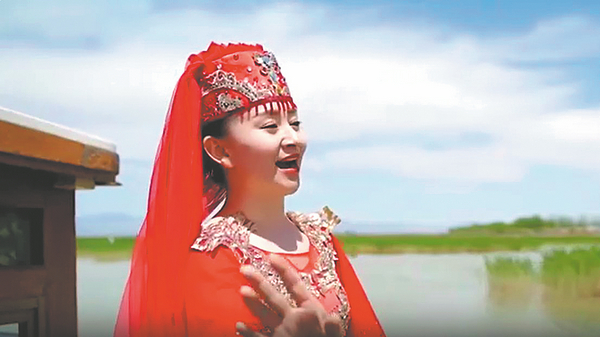
 0 Comment(s)
0 Comment(s) Print
Print E-mail Xinhua, July 16, 2024
E-mail Xinhua, July 16, 2024

Sa Lina, a regional inheritor of the intangible cultural heritage of Hua'er, a type of folk song, in the Ningxia Hui autonomous region. XINHUA
Sa Lina, 38, has juggled a hectic schedule recently, performing Hua'er, a type of folk song popular in northwestern China, not only in her hometown in Ningxia Hui autonomous region but also in the neighboring Gansu and Qinghai provinces.
"Over the past two years, the link between culture and tourism has strengthened, creating more opportunities for local folk singers like me to showcase traditional art to tourists," says Sa, who has devoted herself to Hua'er for almost 20 years.
Hua'er, which means flower in Chinese, uses a distinct high pitch and has been exceedingly popular in China's Qinghai and Gansu provinces, and Ningxia Hui and Xinjiang Uygur autonomous regions, for hundreds of years. The Chinese folk song genre, also known as a type of "mountain song", was inscribed by UNESCO on the Representative List of the Intangible Cultural Heritage of Humanity in 2009.
Sa was born in Ningxia's Haiyuan county, dubbed "the hometown of Hua'er". After graduation, she returned to Haiyuan to join a local art troupe and soon became an apprentice under Ma Handong, a well-known Hua'er singer.
In 2013, she was named an inheritor of Hua'er, becoming the youngest inheritor of the intangible cultural heritage at the regional level at the time.
To actively promote Hua'er, platforms and audiences are essential, Sa says, adding that Hua'er and tourism make the perfect combination and their synergy can boost the incomes of tourist sites and expand the influence of Hua'er.
Efforts have been made in this regard and many music festivals were held at tourist sites across Ningxia during this year's May Day holiday.
"We chose a performance arena close to the display and sales areas of local commodities and snacks, which better connects folk culture and consumption," says Zhang Yingqing, director of the tourism department in the county of Tongxin in Ningxia.
According to Zhang, a three-day event held in Tongxin during the holiday gained popularity among tourists and locals, attracting more than 10,000 people in a single night.
Hua'er has also been integrated into music dramas, operas and dance dramas. For example, in Shanhaiqing, an opera adapted from a famous Chinese anti-poverty TV series, Hua'er plays an important role.
"Infused with modern elements, the traditional art of Hua'er can cater to the evolving tastes of listeners," says Sa. "Art should not only be inherited but also innovated."
According to Zhang, a Hua'er stage play based on local revolutionary stories will be performed in a local 4A-level scenic spot. "We really hope the traditional art can help boost the popularity of local tourism," he says.